ECU AUDI A4 2016 User Guide
[x] Cancel search | Manufacturer: AUDI, Model Year: 2016, Model line: A4, Model: AUDI A4 2016Pages: 278, PDF Size: 70.26 MB
Page 72 of 278
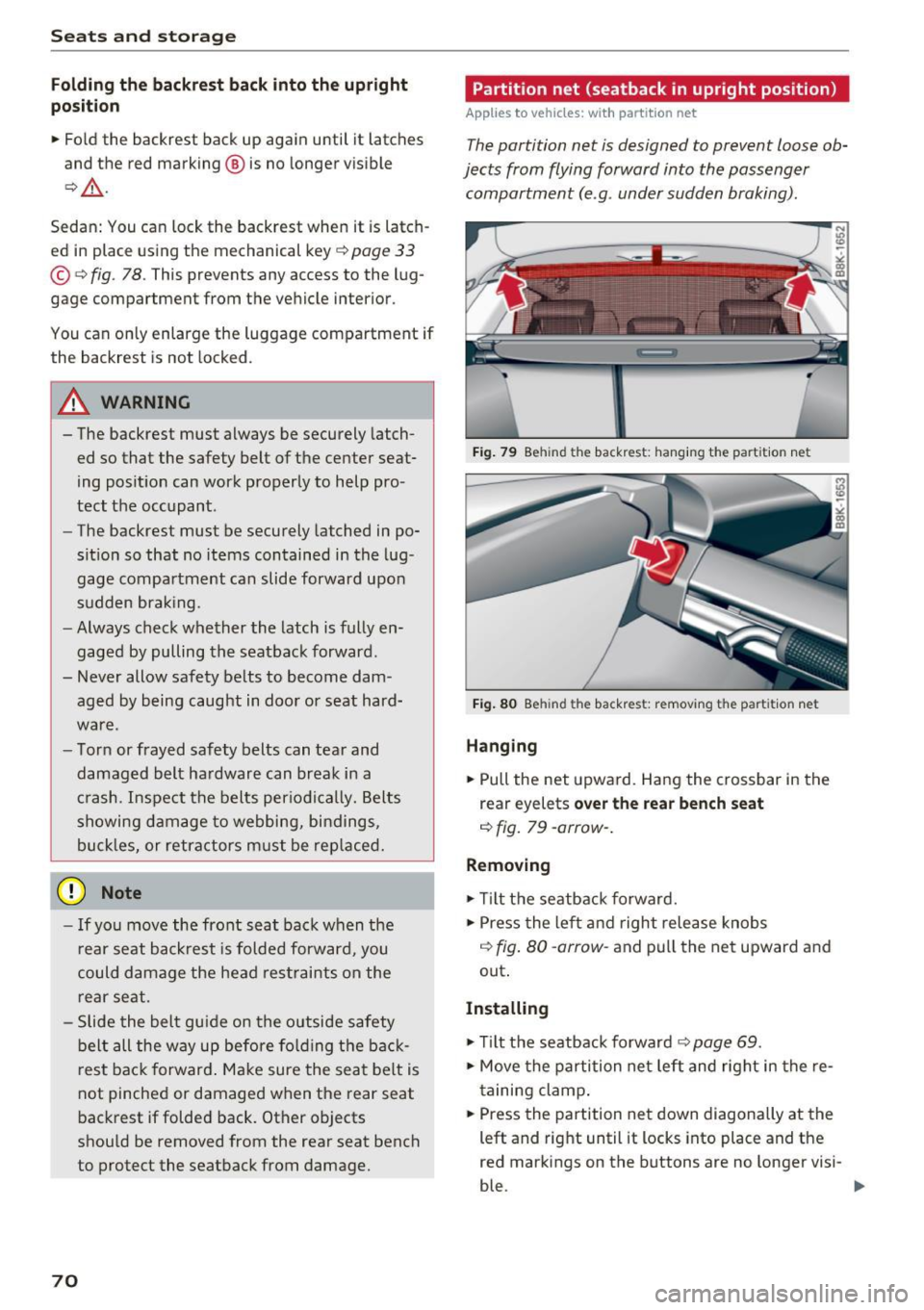
Sea ts and stor age
Folding the ba ckrest back into the up right
po sit ion
.. Fo ld the backrest back up again until it latches
and the red marking @ is no longer visible
c> & .
Sedan: You can lock the backrest when it is latch
ed in place using the mechanical key ¢
page 33
© co> fig. 78. This prevents any access to the lug
gage compartment from the vehicle interior .
You can only enlarge the luggage compartment if
the backrest is not locked.
A WARNING
- The backrest must always be securely latch
ed so that the safety belt of the center seat
ing posit ion can work properly to help pro
tect the occupant.
- The backrest must be securely latched in po
sit ion so that no items contained in the lug
gage compartment can slide forward upo n
s u dden brak ing.
- Always check whe ther the latch is f ully en
gaged by pulling the seatback forward .
- Never allow safety be lts to become dam
aged by being caught in doo r or seat hard
ware.
- Tor n or frayed safety belts can tear and
damaged belt ha rdware can break in a
c rash. Inspect the belts per io d ically. Belts
showing dam age to webbing, bi ndings,
bu ck les, or retractors m ust be rep laced.
(D Note
- If you move the front seat back when the
rear seat bac kres t is folded forward, you
could damage the head res traints on the
rear se at.
- Slide the bel t gu ide on the outside safety
belt all the way up before fo lding the ba ck
r est bac k forward . Ma ke sure the seat be lt is
not pinched or damaged when the rear seat
b ackrest if folded back. Other objects
shou ld be removed from the rear seat bench
to protect the seatback from damage.
70
Partition net (seatback in upright position)
Applies to vehicles: with partit ion net
The partition net is designed to prevent loose ob
jects from flying forward into the passenger
compartment (e .g . under sudden braking).
F ig . 79 Be hind the backrest : hang ing the part it ion net
F ig . 8 0 Beh ind the backrest: removi ng the part it ion net
Hanging
.. Pull the net upward. Hang the crossbar in the
rear eyelets
over the rear bench seat
¢fig. 79-arrow- .
Removing
.. Til t the seatb ack forward .
.. Press the le ft a nd right release knobs
q fig. 80 -arrow -and pu ll the net upward and
out .
Installing
.. Til t the seatback forward ¢ page 69.
.. Move the partition ne t left and right in the re
t aining clamp .
.. Press the partition net down diagonally at the
left and right until it locks into place and the
red markings on the buttons are no longer visi-
ble. ..,_
Page 74 of 278

Sea ts and stor age
In a collision, the laws of physics mean that even
smaller items that are loose in th e vehicle will
turn into heavy missiles that can cause serio us in
jury . Items in the veh icle pick up kinetic energy
which varies wi th the vehicle and the weight of
the item . Vehicle speed is the most significant
factor .
For examp le, in a frontal collision at a speed of
30 mph (48 km/h), the forces acting on a 10-lb (5 kg) object a re about
20 times the normal
weight of the item. Th is means that t he weight
of the item would suddenly be the equiva lent of
about 200 lbs (90 kg) . One can easily imagine the
i n jur ies that an i tem of that we igh t fly ing free ly
through the passenger compartment can cause
in a co llision at a speed considered relatively low .
A WARNING
Weak, damaged or improper straps used to
secure items to tie-downs can fail d uring hard
brak ing or in a collision and cause serious per
sonal i njury.
-Always use suitab le reta ining straps and
properly secure items to the tie-downs in
the luggage compartment to help prevent
items from shifting or f lying forward .
- Never attach a child seat tether strap to a
tie-down.
- For strength-related reasons., the mounting
hooks can on ly be used to secure objects
weighing up to 10 lb . (5 kg) . H eavier objects
will not be adequate ly secured -there is a
risk of injury.
72
-
Tie-downs
App lies to vehicles: with tie -downs
F our tie-downs for securing luggage pieces and
two for hanging bags, sacks, etc. are located in
the luggage compartment.
F ig . 85 Lug gage compar tme nt: tie -d owns
.. Secure objects us ing elastic cords attached to
the tie-downs*
¢ fig. 85.
.. Read and heed all WARN INGS c:;, page 126 ,
Storing cargo correctly.
Bag hooks
Applies to vehicles: with bag hooks
Light objects can be secured on the hooks.
Fig. 86 Rig ht side o f the luggage compart ment : bag hooks
You can also use the hooks to hang ligh t purses,
bags, etc.
A WARNING
T he hoo ks can ho ld a m aximum weigh t of 3
kg. Heavier objec ts are not adequate ly se
cured. There is r isk of persona l injury .
-
Page 75 of 278
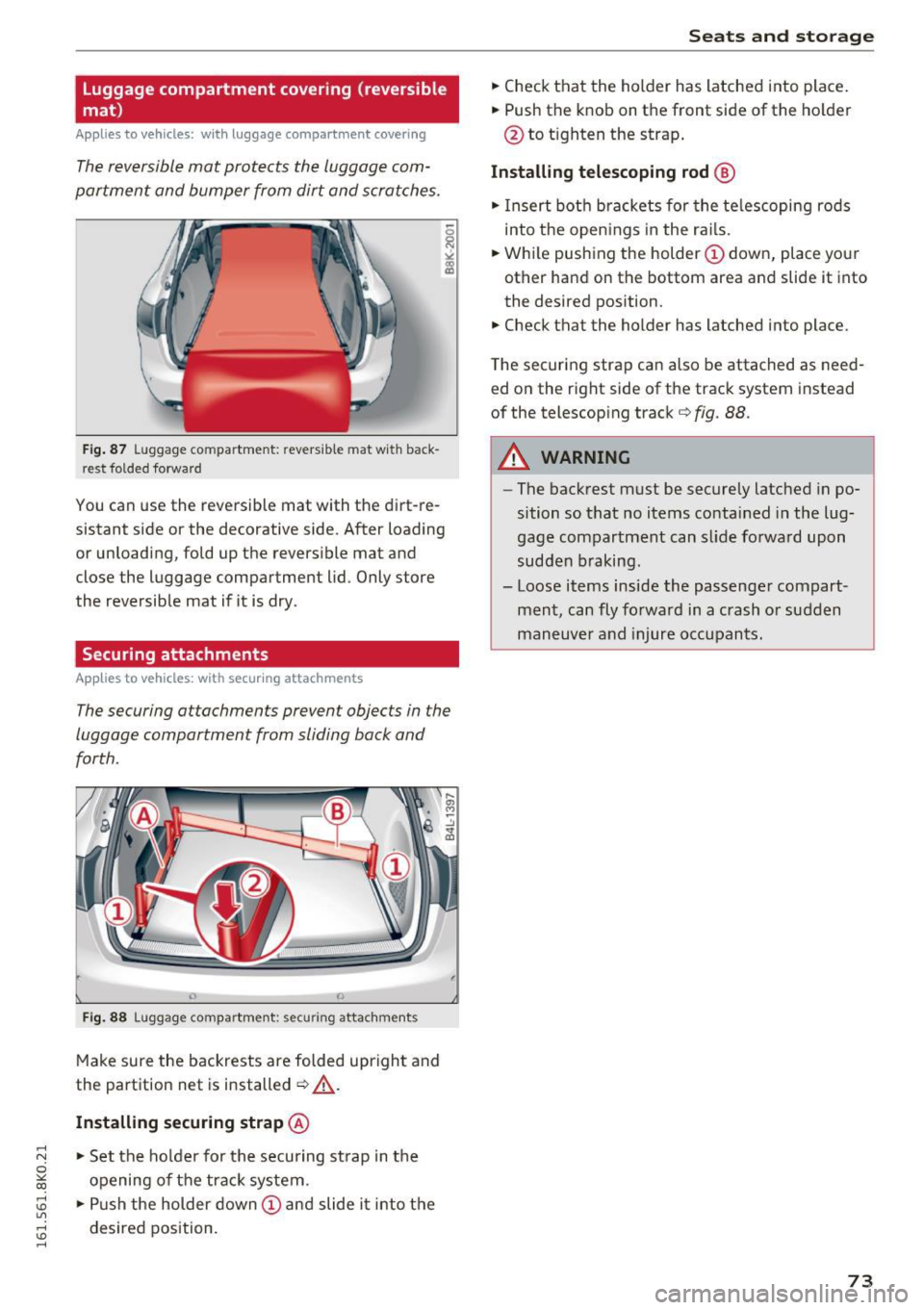
,....,
N
0
""' CX) ,....,
I.Cl U"I ,....,
I.Cl ,....,
Luggage compartment covering (reversible
mat)
Applies to vehicles: with luggage compartment covering
The reversible mat protects the luggage com
partment and bumper from dirt and scratches .
Fig. 87 Lugg age co mpartment : rever sib le m at wit h back
r est folded fo rwa rd
You can use the reversible mat with the d irt -re
sistant side o r the decorative side . After loading
or unloading, fold up the revers ible mat and
close the luggage compartment lid . Only store
the reversible mat if it is dry .
Securing attachments
Applies to vehicles: with securing attachments
The securing attachments prevent objects in the
luggage compartment from sliding back and
forth.
0 0
Fig . 88 Luggage compartm ent : se curin g attachments
Make sure the backrests are folded upright and
the partition net is installed ¢
&,.
Installing securing strap @
.,. Set the ho lder for the securing strap in the
opening of the track system .
.,. Push the holder down
CD and slide i t into the
desired position.
Seats and storag e
.,. Check that the holder has latched into place .
.,. Push the knob on the front side of the ho lder
@ to tighten the strap .
Installing telescoping rod @
.,. Insert both brackets for the telescoping rods
into the open ings in the ra ils .
.,. Whi le pushing the holder
CD down, place your
other hand on th e bottom area and slide it into
the desi red position .
.,. Check that the holder has latched into place.
T he securing strap can also be attached as need
ed on the right s ide of the track system instead
of the telescop ing track ¢
fig. 88 .
A WARNING
--The backrest must be securely latched in po-
sition so that no items co ntained in the lug
gage compartment can slide forward upon
sudden braking .
- Loose items inside the passenger compart ment , can fly forward in a crash or sudden
maneuver and injure occupants.
73
Page 76 of 278

Sea ts and stor age
Ski sack
Applies to vehicles: w ith sk i sack
Long objects such as skis or snowboards can be
transported in the ski sack .
Fig. 89 Backrest : pass-throug h cover
F ig . 90 Rear bench sea t: securing the ski sack
Loading
.,. Fold the rea r seat center armrest down.
.,. Fol d the pass -through cover ¢
fig. 89 -arrow
down.
.,. Slide the ski sack from the luggage compart
ment through the pass-through with the zipper
at the rear ¢,&. .
Secur ing
.,. Inse rt the ski sack strap@¢ fig. 90 in the cen
ter buck le @ .
.,. Pull the safety belt taut on the free end of the
belt @.
A WARNING
-The ski sack is intended only for the trans
portation of skis and other light objects . To
reduce the risk of serio us pe rsonal injury,
never transpo rt heavy o r po inted objects in
the ski sa ck.
74
-
-W hen braking rapidly or during an accident,
the load could be displaced and cause injury
to occupants.
- Sharp edges on the load must be covered
for protection . Always fasten the be lt t ight
ly around the sack and its contents
¢fig. 90.
-For safety reasons, do not transport more
than two pairs of skis in t he ski sack.
- You must secure the ski sack with the strap
after loadi ng.
- Make sure that all objects you are transport
ing in the pass-through are secured. Othe r
wise they could slide around during sudden braking maneuvers and cause injur ies.
{!) Tips
- Never stow the ski sack away when it is still
wet or damp (for example, snow melting
from skis) . Allow it to dry completely before
stowing it away .
- Whe n transporting skis or snowboards,
t ighten the securing strap between the
bind ings.
- Pos it ion skis in the ski sack with the pointed
ends facing the front and sk i poles with the
pointed ends facing the rear.
- Sedan: You can lock or unlock the pass
throug h using the mecha nical key . This pre
vents any access to the luggag e compart
ment from the veh icle inter io r .
Page 87 of 278
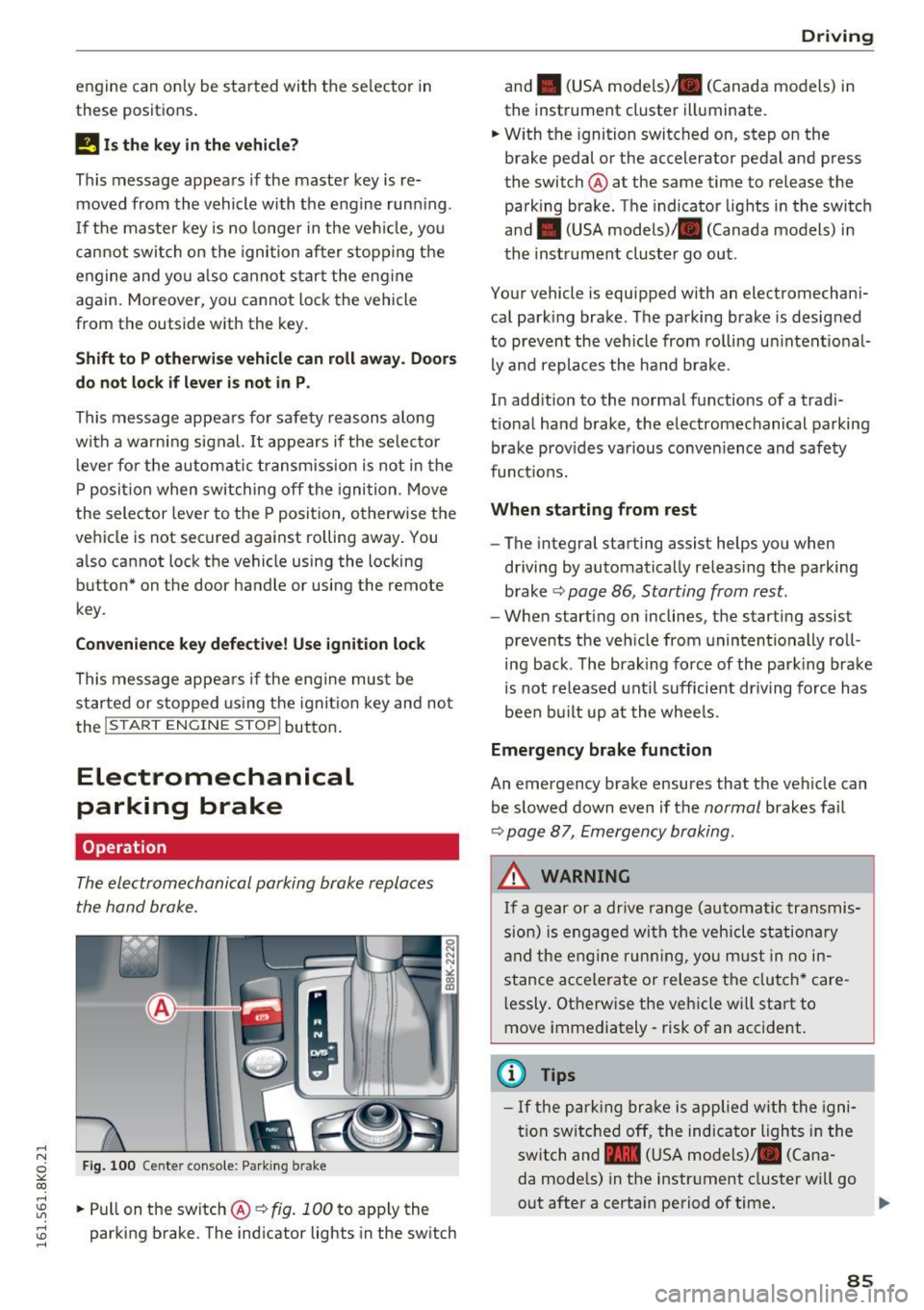
.... N
0
""' CX)
engine can only be star ted with the se lector in
these positions .
!I Is the key in the v ehicle?
This message appears if the master key is re
moved from the vehicle with the engine run ning .
If the maste r key is no longer in the veh icle, you
cannot swi tch on the ignition after stopping the
engine and yo u also cannot start the engine
again. Moreover, you cannot lock the vehicle
from the outside with the key .
Shift to P otherwise vehicle can roll away . Door s
do not lo ck if l ever i s not in
P.
This message appears fo r safety reasons a long
with a warning signal. It appears if the selec to r
l eve r fo r th e automatic transmission is not in the
P posit ion when switching off the ignition . M ove
the selector leve r to the P position, otherwise the
ve hicle is not secured against rolling away. You
also cannot lock the vehicle using the locking button* on the door handle or using the remote
key.
Con venien ce key d efectiv e! Use ignition lo ck
This message appea rs if the engine mus t be
s t arted or stopped us ing t he igni tion key and no t
the
! START ENGINE STOPI button .
Electromechanical
parking brake
Operation
The electromechanical parking brake replaces
the hand brake.
Fig . 100 Ce nter conso le: Park ing b rake
....
~ .. Pull on the switch@~ fig. 100 to apply the
~ parking brake. The ind icator lights in the sw itch ....
D rivi ng
and . (USA mode ls)/ . (Canada models) in
the instrument cluster illuminate.
.. W ith the ignition switc hed on, step on the
brake pedal or the accelerator pedal and press
the switch @ at the same time to release the
parking brake . The indicator lights in the switch
and . (USA models)/ . (Canada models) in
the instrument cluster go out .
Your vehicle is equipped with an electromechani
cal park ing brake. The parking brake is designed
to prevent the vehicle from rolling un intent ional
ly and replaces the ha nd b rake .
In add ition to the normal functions of a trad i
t ional ha nd brake, the electromechanical parking
brake prov ides va rious conven ience and safety
funct ions.
When starting from rest
- The integral starting assist helps you when
driving by automatically releas ing the parking
brake ~
page 86 , Starting from rest.
- When start ing on inclines, the starting assist
prevents the veh icle from unintentionally roll
ing back . T he brak ing force of the park ing brake
is not re leased unt il sufficient dr iving force has
been bu ilt up at the whee ls.
Emergency brake function
An emergency brake ensures that the veh icle can
be slowed down even if the
normal brakes fa il
~ page 8 7, Emergency braking .
A WARNING
If a gear or a drive range (automatic transmis
s ion) is engaged wi th the vehicle stationa ry
a nd the engine runn ing, you must in no in
stance acce lera te or release the clutch* care
l essly. Otherwise the vehicle wi ll sta rt to
move immediately- risk of an accident.
(1) Tips
- If the pa rk ing br ake is a pplied with the igni
tion swi tche d off, the indicator lights i n the
switch and -(USA models) . (Cana
da mode ls) in the instr ument cluster wi ll go
out after a certain period of time .
85
Page 96 of 278
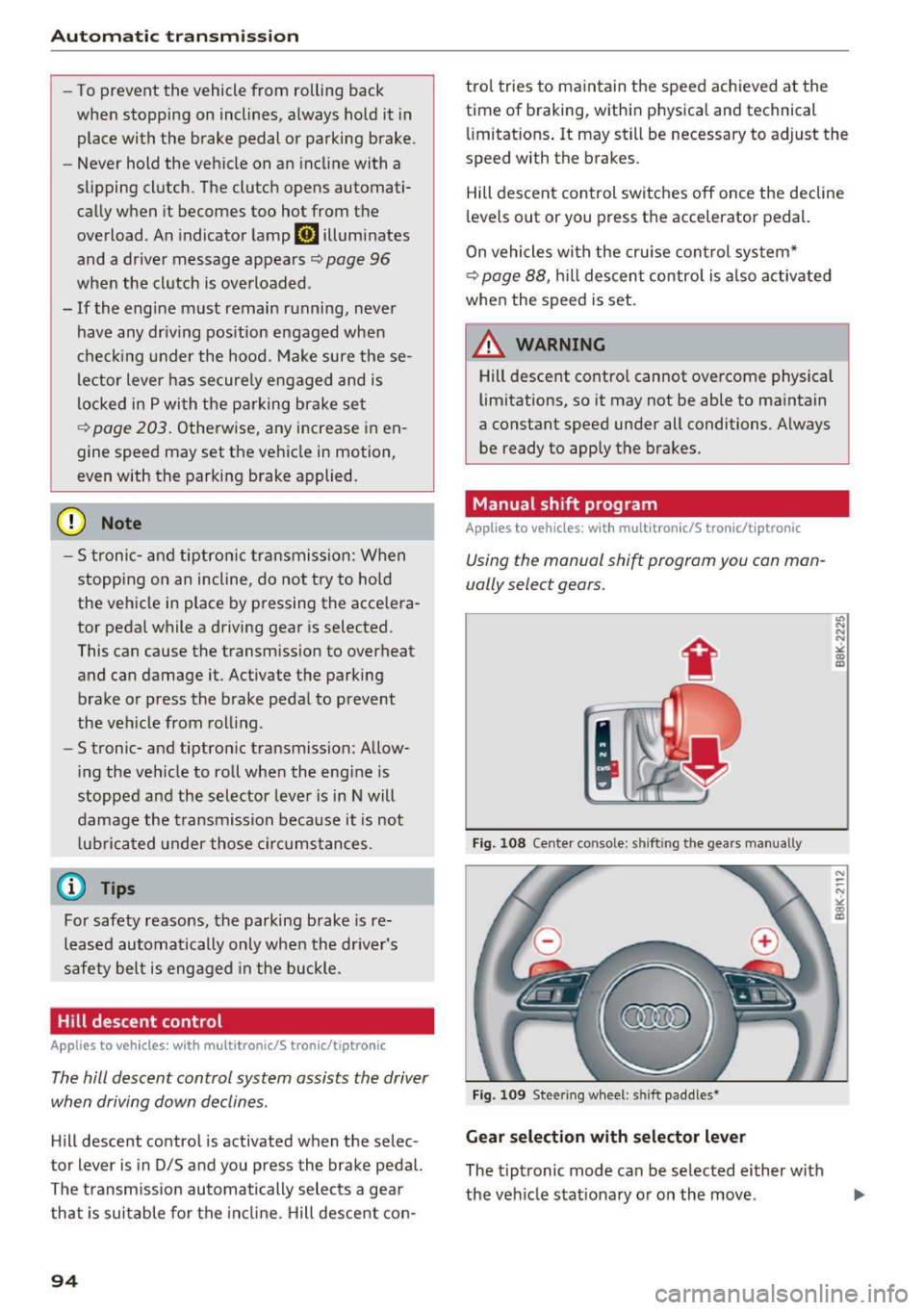
Automat ic t ra nsm iss io n
-To prevent the vehicle from rolling back
when stopping on inclines, a lways hold it in
place with the brake pedal or parking brake.
- Never hold the vehicle on an incline with a
s li pping clutch. The clutch opens automati
cally when it becomes too hot from the
overload . An indicator lamp
mJ illuminates
and a driver message appears
~ page 96
when the cl utch is overloaded.
- If the engine must remain running, never
have any dr iv ing pos ition engaged when
checking under the hood. Make sure these
lector lever has secure ly engaged and is
locked in P with the parking bra ke set
~ page 203. Otherwise, any increase in en
gine speed may set the vehicle in motion,
even with the parking brake applied.
- S tronic- and tiptron ic transmission: When
stopping on an incline, do not try to ho ld
the vehicle in place by pressing the acce lera
tor pedal while a driving gear is selected.
This can cause the transm ission to overheat
and can damage it. Activate the parking brake or press the brake pedal to prevent
the vehicle from rol ling .
- S tronic- and tiptron ic transmission: Allow
i ng the veh icle to roll when the eng ine is
stopped and the selector leve r is in N will
damage the transmission because it is not
l ub ricated under those c ircumstances .
(D Tips
For safety reasons, the parking brake is re
leased automatically only when the driver's
safety belt is engaged in the buckle.
Hill descent control
Applies to vehicles: with multitro nic/5 tronic/tip tronic
The hill descent control system assists the driver
when driving down declines.
H ill descent control is activated when the selec
tor lever is in D/S and you press the brake pedal.
The transmission au tomatically selects a gear
that is suitable for the in cl ine. Hill descent con-
94
trol tries to maintain the speed achieved at the
time of braking, within physica l and techn ical
li mitations .
It may still be necessary to adjust the
speed with the brakes .
Hill descent control switches off once the decline
l evels out or you press the accel erator pedal.
On vehicles with the cruise control system*
~ page 88 , hill descent control is a lso activated
when the speed is set.
./1. WARNING
Hill descent control cannot overcome physical
limitations, so it may not be able to maintain
a constant speed under all conditions . A lways
be ready to apply the brakes .
Manual shift program
Applies to vehicles: with multitronic/5 tronic/tiptronic
Using the manual shift program you con man
ually select gears.
Fig. 108 Cente r co n sole: s hift in g the gea rs m anually
Fig. 109 Stee ring whee l: shift paddle s•
Gear selection w ith selector lever
The tiptronic mode can be se lected either w ith
the veh icle stat ionary or on the move .
"' N N
N
"' CD m
N ~ N ><'. co m
Page 107 of 278

..... N
0 ::..:: co .....
promptly detected or may not be detected
at all.
- Reflective surfaces including crash barriers
or tunnel entrances may impair the function
of the radar sensor.
(D Tips
- You can cancel the braking that is initiated
by the system by braking yourse lf, by accel
erating noticeably or by swerving.
- Braking guard error messages ~page
105 .
-Keep in mind that braking guard can brake
unexpected ly. Always secure any cargo or
objects that you are transporting to reduce
the risk of damage or injury.
Settings in the radio/MM!
A ppl ies to vehicles: with Audi adaptive cruise co ntro l
... Se lect : I CARI funct ion button > C ar s ystem s*
control button > Driver a ssi st > Audi brak ing
guard .
Or
... Select:
~I C-A-R~I funct ion button > A udi braking
g uard .
S ystem -
Switch Audi braking guard On and Off.
When you sw itch the ignition on, the message
Audi bra king gua rd off appears if the system is
switched off.
Ea rly warn ing -The distance and approach warn
ings in the display can be switched
On /Off .
(D Tips
-Your settings are automatically stored and
ass igned to the remote control key being
used at the times the sett ings are made.
- If you restrict or sw itch off the ESC, the
braking guard also sw itches itself off
~ page
178 .
- Switch braking guard off when you are load
ing the veh icle onto a vehicle ca rr ier, train,
sh ip or other type of transportation . This
can p revent undesired warnings from the
braking gua rd system .
Messages
Applies to vehicles: wi th Aud i adapt ive c ruise control
Braking guard : Off
This dr iver message appears if the system is
tu rned off via the radio/MM I*. O therwise, if the
system is turne d off, the information appears ev
ery time shortly after t he start o f the trip .
T he driver message a lso appea rs if the system is
not avai lab le due to a ma lfunction o r if the ES C i s
not switched on¢ page
178 . If th is is the case,
the system wi ll not provide warnings about a
possib le collision .
Braking guard : A ctivated
This dr iver message appears if sharp brake pres
su re was applied due to an acute warning .
•••
Three white dots appear if a setting cannot be se
l ected with the operating lever. For example, this
happens if you want to raise/lower the speed
even though there was no previously saved
speed .
ACC: Deacti vation
The driver message appears in vehicles wi th ma n
u al transmission. If the clutch pedal was pressed
down for too long , the adaptive cr uise control
tu rns off. A chime sounds as a reminder.
ACC : Sen sor blocked
This message appears if the senso r view is ob
structed, for examp le by leaves, snow, heavy
spray or dirt. Clean the sensor¢ page
98,
fig. 112 .
ACC : not availa ble
The driver message appears if there is a malfunc
tion. The adaptive cruise control turns off . A
chime so unds as a reminder . Have the system
c h ecked by an author ized Audi dealer or au thor
ized Audi Service Facili ty.
A CC: una vailable
The driver message appears if, for examp le, the
brake temperature is too high. The adapt ive .,.
105
Page 123 of 278
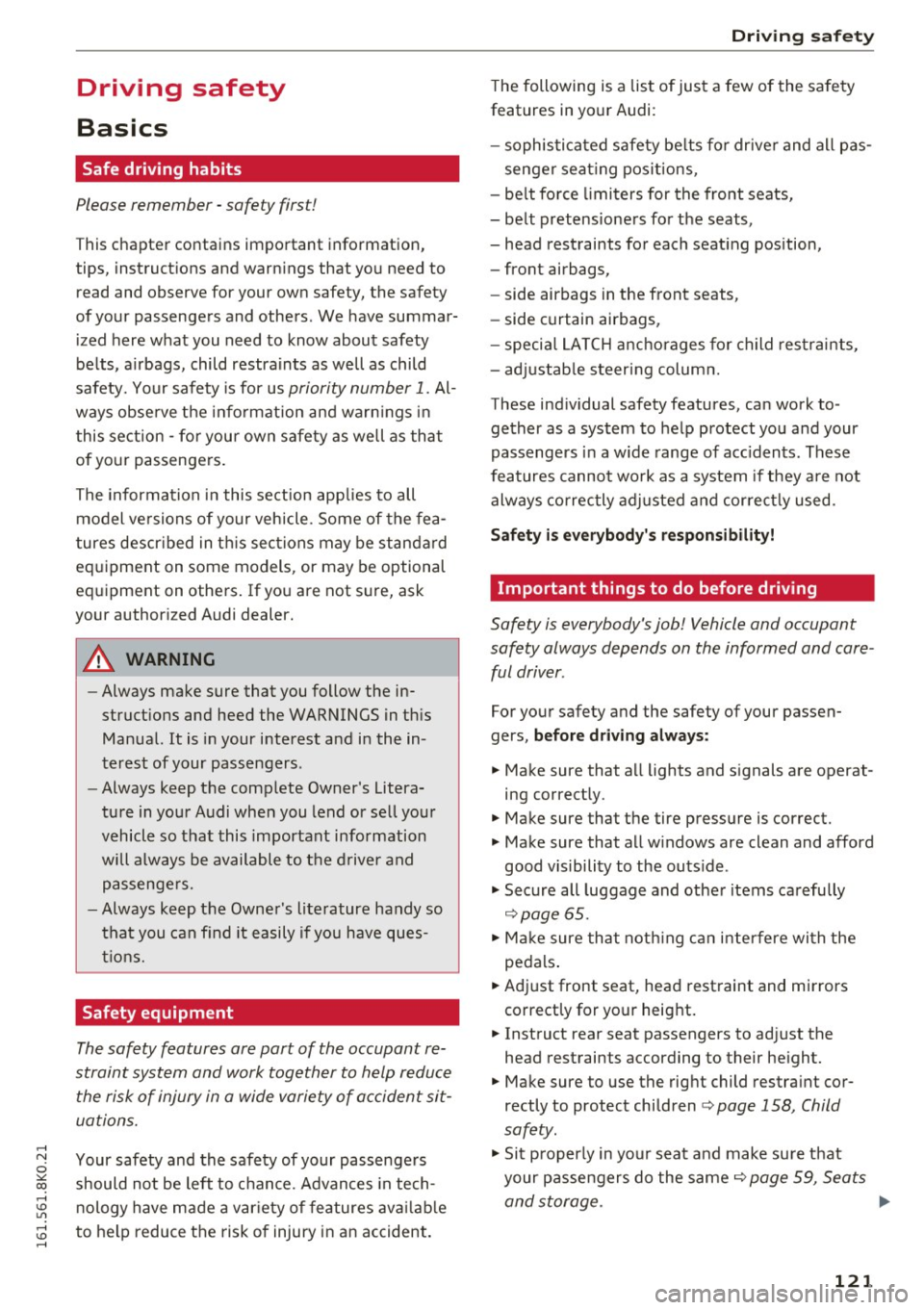
..... N
0 ::..:: co ,....,
Basics
Safe driving habits
Please remember -safety first!
This chapter contains important information,
tips, instructions and warnings that you need to
read and observe for your own safety, the safety
of your passengers and others . We have summar
ized here what you need to know about safety
belts, airbags, child restraints as well as child
safety. Your safety is for us
priority number 1. Al
ways observe the information and warnings in
this section - for your own safety as well as that
of your passengers.
The information in this section applies to all
model versions of your vehicle. Some of the fea
tures descr ibed in this sections may be standard
equipment on some models, or may be optional
equipment on others. If you are not sure, ask
your authorized Audi dealer.
A WARNING
- Always make sure that you follow the in
structions and heed the WARNINGS in this
Manual. It is in your interest and in the in
terest of your passengers .
-
-Always keep the complete Owner's Litera
ture in your Audi when you lend or sell your
vehicle so that this important information
will always be available to the driver and
passengers.
- Always keep the Owner's literature handy so
that you can find it easily if you have ques
tions.
Safety equipment
The safety features are part of the occupant re
straint system and work together to help reduce
the risk of injury in a wide variety of accident sit
uations.
Your safety and the safety of your passengers
should not be left to chance. Advances in tech
nology have made a var iety of features available
to help reduce the risk of injury in an accident.
Driving safety
The following is a list of just a few of the safety
features in your Audi:
- sophisticated safety belts for driver and all pas-
senger seat ing pos itions,
- be lt force limiters for the front seats,
- belt pretensioners for the seats,
- head restraints for each seating position,
- front airbags,
- side airbags in the front seats,
- side curtain airbags,
- specia l LATCH anchorages for child restraints,
- adjustable steering column.
These individual safety features, can work to gether as a system to help protect you and your
passengers in a w ide range of accidents. These
features cannot work as a system if they are not
always correctly adjusted and correctly used.
Safety is everybody's responsibility!
Important things to do before driving
Safety is everybody's job! Vehicle and occupant
safety always depends on the informed and care
ful driver.
For your safety and the safety of your passen
gers,
before driving always:
.. Make sure that all lights and signals are operat
ing correctly.
.. Make sure that the tire pressure is correct.
.. Make sure that all windows are clean and afford
good visibility to the outside .
.. Secure all luggage and other items carefully
c:::>page 65.
.. Make sure that nothing can interfere with the
pedals .
.. Adjust front seat, head restraint and mirrors
correctly for your height.
.. Instruct rear seat passengers to adjust the
head restraints according to their height.
.. Make sure to use the right child restraint cor
rectly to protect children
c:::> page 158, Child
safety .
.. Sit properly in your seat and make sure that
your passengers do the same
c:::> page 59, Seats
and storage.
121
Page 126 of 278
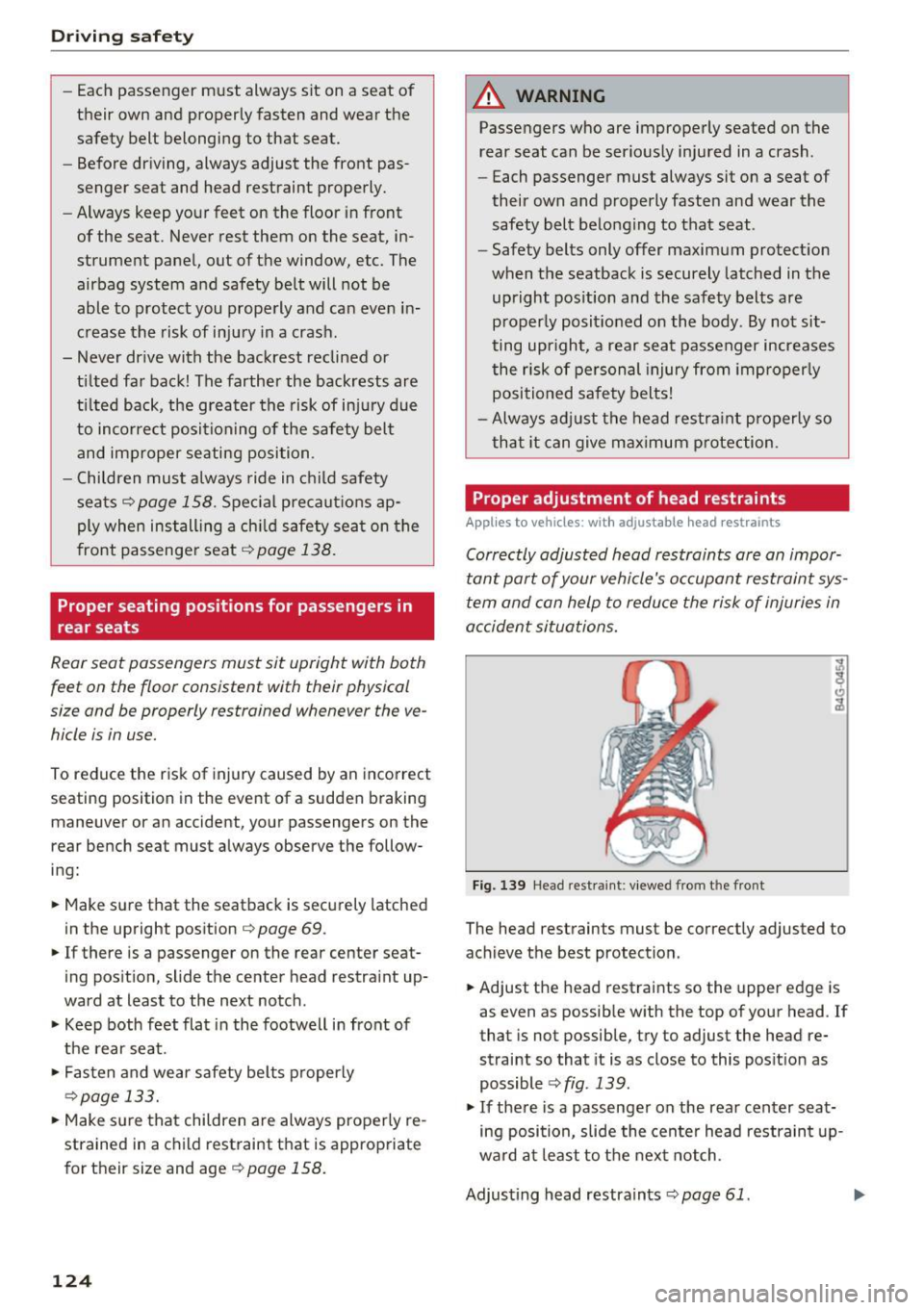
Driving safety
-Each passenger must always sit on a seat of
their own and properly fasten and wear the
safety belt belonging to that seat.
- Before driving, always adjust the front pas
senger seat and head restraint properly.
- Always keep your feet on the floor in front
of the seat. Never rest them on the seat in-
'
strument panel, out of the window, etc. The
airbag system and safety belt will not be
able to protect you properly and can even in
crease the risk of injury in a crash.
- Never drive with the backrest reclined or
tilted far back! The farther the backrests are
t il ted back, the greater the risk of injury due
to incorrect positioning of the safety belt
and improper seating position.
- Children must always ride in child safety
seats ¢
page 158. Special precaut ions ap
ply when installing a child safety seat on the
front passenger seat¢
page 138.
Proper seating positions for passengers in
rear seats
Rear seat passengers must sit upright with both
feet on the floor consistent with their physical
size and b e properly restrained wh enever the ve
hicle i s in use.
To reduce the risk of injury caused by an incorrect
seating position in the event of a sudden braking
maneuver or an accident, your passengers on the
rear bench sea t must always observe the follow
ing:
... Make sure that the seatback is securely latched
in the upright position ¢
page 69.
... If there is a passenger on the rear center seat
ing position, slide the center head restra int up
ward at least to the next notch .
... Keep both feet flat in the footwell in front of
the rear seat.
.,. Fasten and wear safety be lts properly
¢ page 133.
... Make sure that children are always properly re
strained in a child restraint that is appropriate
for their size and age¢
page 158.
124
A WARNING
Passengers who are improperly seated on the
rear seat can be seriously injured in a crash.
- Each passenger must always sit on a seat of
their own and properly fasten and wear the
safety belt belonging to that seat .
- Safety belts only offer maximum protection
when the seatback is securely latched in the
upright position and the safety belts are
properly positioned on the body . By not sit
ting upr ight, a rear seat passenger increases
the risk of personal injury from improperly
positioned safety belts!
-Always adjust the head restraint properly so
that it can give maximum protection.
Proper adjustment of head restraints
Applies to vehicles: with adjustable head restra ints
Correctly adjusted head restraints are an impor
tant part of your vehicle's occupant restraint sys
tem and can help to reduce the risk of injuries in
accident situations.
Fig. 139 He ad restraint : viewe d from t he front
The head restraints must be correctly adjusted to
achieve the best protection .
... Adjust the head restraints so the upper edge is
as even as possible with the top of your head . If
that is not possible, try to adjust the head re
straint so that it is as close to this position as
possible ¢
fig. 139 .
... If there is a passenger on the rear center seat
ing position, slide the center head restraint up
ward at least to the next notch .
Adjusting head restraints¢
page 61.
Page 127 of 278
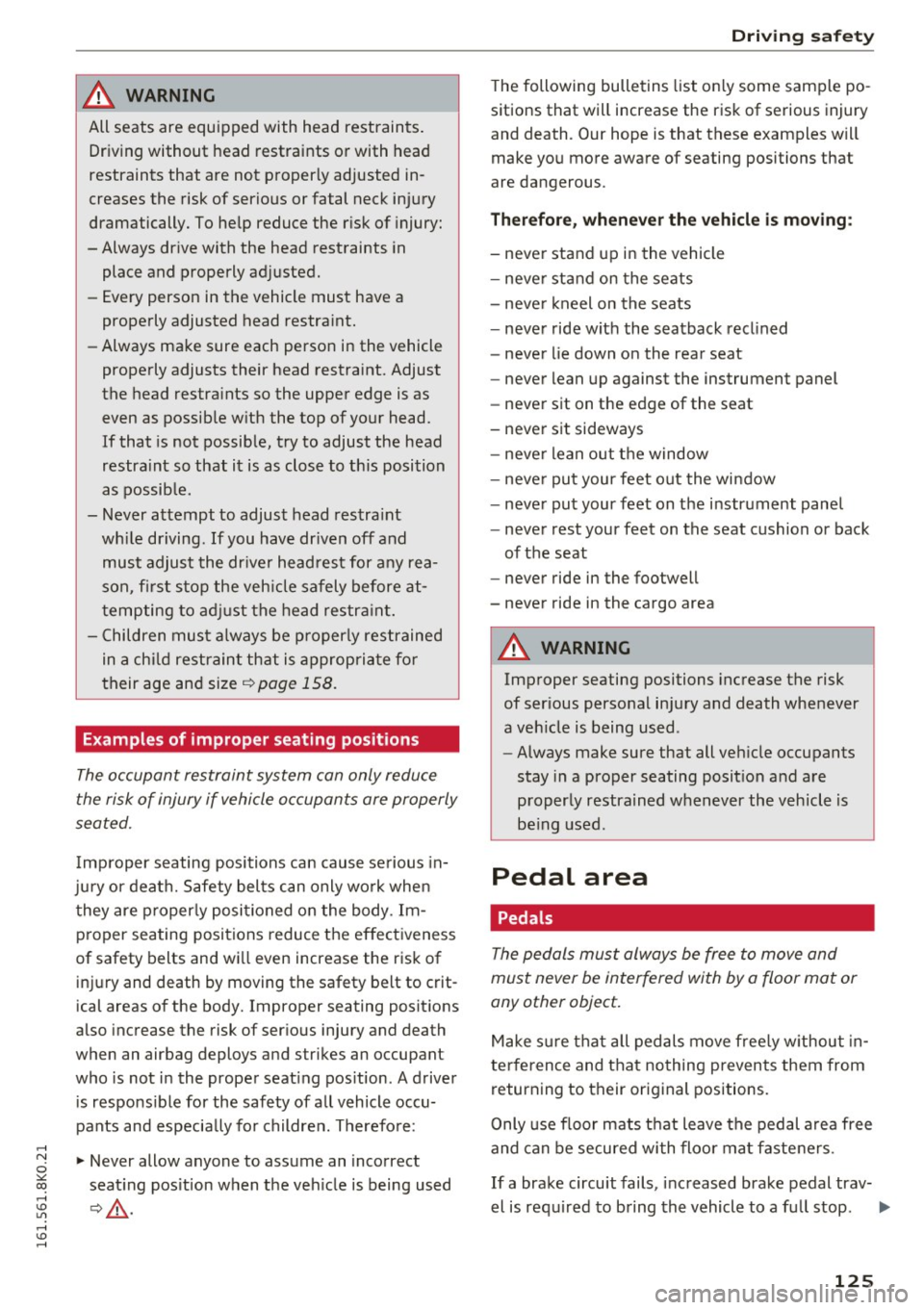
..... N
0 ::..:: co ,....,
All seats are equipped with head restraints. Driving without head restraints or with head
restraints that are not properly adjusted in
creases the risk of serious or fatal neck injury
dramatically. To help reduce the risk of injury:
-Always drive with the head restraints in
place and properly adjusted.
- Every person in the vehicle must have a
properly adjusted head restraint.
- Always make sure each person in the vehicle
properly adjusts their head restraint. Adjust
the head restraints so the upper edge is as
even as possible with the top of your head.
If that is not possible, try to adjust the head
restraint so that it is as close to this position
as possible.
- Never attempt to adjust head restraint
whi le driving. If you have driven off and
must adjust the driver headrest for any rea
son, first stop the vehicle safely before at
tempting to adjust the head restra int.
- Children must always be properly restrained
in a child restraint that is appropriate for
their age and size
q page 158.
Examples of improper seating positions
-
The occupant restraint system con only reduce
the risk of injury if vehicle occupants ore properly
seated.
Improper seating positions can cause serious in
jury or death. Safety belts can only work when
they are properly positioned on the body. Im
proper seating positions reduce the effectiveness
of safety belts and will even increase the risk of
injury and death by moving the safety belt to crit
ical areas of the body. Improper seating positions
also increase the risk of serious injury and death
when an airbag deploys and strikes an occupant
who is not in the proper seating position. A driver
is responsible for the safety of all vehicle occu
pants and especia lly for children. Therefore:
.. Never allow anyone to assume an incorrect
seating position when the vehicle is being used
q& ,
Driving safety
The following bulletins list only some sample po
sitions that will increase the risk of serious injury
and death. Our hope is that these examples will
make you more aware of seating positions that
are dangerous .
Therefore, whenever the vehicle is moving:
-never stand up in the vehicle
- never stand on the seats
- never kneel on the seats
- never ride with the seatback reclined
- never lie down on the rear seat
- never lean up against the instrument panel
- never sit on the edge of the seat
- never sit sideways
- never lean out the window
- never put your feet out the window
- never put your feet on the instrument panel
- never rest your feet on the seat cushion or back
of the seat
- never ride in the footwell
- never ride in the cargo area
A WARNING
-Improper seating positions increase the risk
of serious personal injury and death whenever
a vehicle is being used.
- Always make sure that all vehicle occupants
stay in a proper seating position and are
properly restrained whenever the vehicle is
being used.
Pedal area
Pedals
The pedals must always be free to move and
must never be interfered with by a floor mot or
any other object.
Make sure that all pedals move freely w ithout in
terference and that nothing prevents them from
returning to their original positions .
Only use floor mats that leave the pedal area free
and can be secured with floor mat fasteners .
If a brake circuit fails, increased brake pedal trav-
el is required to bring the vehicle to a fu ll stop . .,._
125